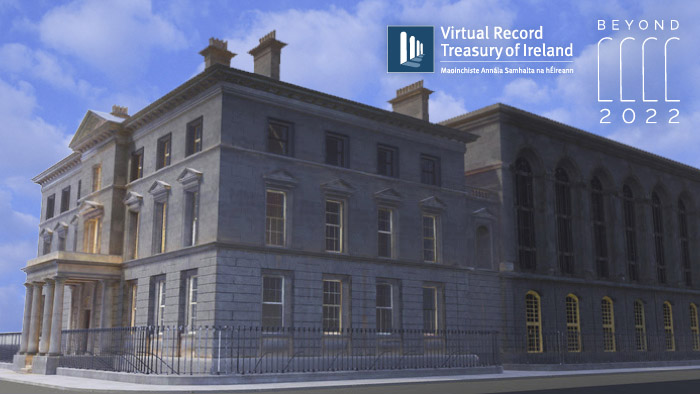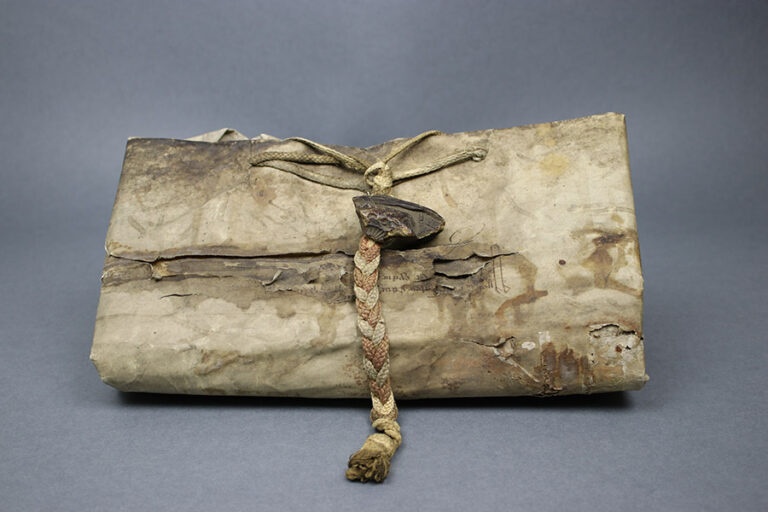A momentous anniversary is approaching. 30 June 2022 marks the centenary of the destruction of the Four Courts in Dublin in the opening engagement of the Irish Civil War.
Located within the Four Courts complex along the River Liffey was the Public Records Office of Ireland, where seven centuries of Irish archival history was stored. Having been occupied by forces opposed to the Anglo-Irish Treaty of 1921 and the subsequent partition of Ireland, shelling of the building began on 28 June 1922, and by 30 June it had caught fire. With it went much of the archival collections.
Such was the extent of the destruction that little of the building survived except the remains of the steel structure of the repository. In the subsequent weeks, months and years, the staff assessed the damage and made efforts to collect and stabilise the partial collections that had survived. Now, however, technological advances and a renewed interest have made it possible to assess fully what has been lost and through a project called Beyond 2022, the Virtual Record Treasury of Ireland will launch on 27 June 2022.

The Beyond 2022 team is multi-faceted: it is composed of historians, archivists, computer scientists, heritage scientists, and conservators. Based at Trinity College Dublin, it has five core partners (National Archives Ireland, the Public Records Office of Northern Ireland, The National Archives of the UK, the Irish Manuscripts Commission, and the Library at Trinity College Dublin), alongside the participation of over 70 memory institutions worldwide. It is truly a unique collaboration.
I am fortunate to be a co-investigator on the Archival Discovery component where, with colleagues in London, Dublin and Belfast, we have worked for the last five years to assess fully what was in the PROI when it was destroyed, before searching for records that act as replacements for those that were destroyed in 1922.
At The National Archives (UK) we have identified thousands of Irish or Irish-related records, some of which act as direct replacements for those destroyed, while others are directly related to the administration of Ireland since the 12th century but were never stored in the PROI. This number is an extraordinary reflection of the close archival relationship between the three archives that form the core of the collection: Dublin, Belfast and London.
As we worked to identify collections within The National Archives, I was heavily reliant on the knowledge and goodwill of colleagues from across the organisation, many of whom passed on tips of places where I should look for records. One such colleague was Dr Dan Gosling, who is the Early Modern Legal Records Specialist.
Dan was working through boxes of previously unlisted deeds that had been submitted to the Court of Chancery at Westminster, where they formed part of a body of evidence for cases heard before the lord chancellor of England. During the course of this work, Dan came across a previously unknown letter patent, which is an official document that acted as instrument to implement the monarch’s instructions that was authorised by the Great Seal. Dan was able to identify that the patent in question had been issued by the Chancery in Dublin, and would have been authorised by the Great Seal of Ireland.

While we knew Irish matters were heard at the Westminster Chancery, it was only when we started to look closely that we became aware of the sheer volume of Irish matters that were heard – perhaps over 1,000 cases between 1500-1800, all of which demanded documentary evidence about people, places and events in Ireland be submitted to the court. A significant proportion of this was produced in Ireland and is a direct replacement for what was in the PROI in 1922. In effect, these records were hiding in plain sight.
I was very excited by the discovery but we had a problem. Letters patent were written on parchment, which can become very stiff with age. Because it most likely hadn’t been opened more than a few times since the 17th century, it was very resistant to being flattened out, and we feared that any efforts to do so would cause damage.
Fortunately, there is a brilliant team of conservators and heritage scientists at The National Archives, who we turned to for help. Over several weeks they set to work on the document, assessing the best course of treatment before relaxing the parchment so it could be opened out, repairing some of the damage, and preparing it for further scientific and historical analysis. Kat Williams undertook the conservation work and Natalie Brown ensured that we could capture Kat’s work on film.

The following video reflects the generosity and skill of my National Archives colleagues, without whom our work in the Archival Discovery team for Beyond 2022 would have been much less successful.
Keep an eye out on our blog over the coming weeks as well as on the Beyond 2022 website. The Virtual Records Treasury of Ireland will launch and be freely available to the public from 27 June 2022.
I am the great grandson of Patrick and Mary O’Brien. I traced their origin to Cork from where they emigrated to the Uk in the middle of the nineteenth century. I look forward to hearing more about your work as it may enable me to trace further back my Irish roots especially as I wish to claim Irish citizenship.
Why is the embedded video classed by YouTube as “Made for kids”? It means that the video can’t be saved to a playlist, and comments are not allowed (although that’s not necessarily a bad thing). But i would have liked to save it for later.